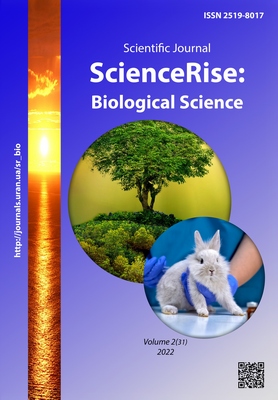The role of connective tissue biopolymers in the pathogenesis of dog bronchopneunmonia and cat brochnial asthma
DOI:
https://doi.org/10.15587/2519-8025.2022.260749Keywords:
dogs, bronchopneumonia, cats, bronchial asthma, pathogenesis, connective tissue, glycoproteins, chondroitin sulfates, glycosaminoglycans, oxyproline, uronic acidsAbstract
The aim: to analyze the pathogenetic role of connective tissue biopolymers in canine pneumonia and feline asthma.
Materials and methods. The study was conducted by analyzing the sources of scientific literature: PubMed, Elsevier, electronic resources of the National Library, named after V.I. Vernadsky and the results of our own scientific and clinical experience.
Results. Studies on the pathogenetic justification of the role of biochemical indicators of the connective tissue in the diagnosis and treatment of diseases of the respiratory system of dogs and cats were conducted. This is due to the need to expand knowledge about the peculiarities of the course, to determine the leading pathogenetic links of the most common pathologies –bronchopneumonia and bronchial asthma, which are found in clinical veterinary practice.
Conclusions. In bronchopneumonia of dogs on the background of severe clinical symptoms (cough, fever, wheezing in the lungs), radiological signs (inhomogeneous compaction of the lung tissue, lack of clear contours of the bronchi), anemic syndrome, general and neutrophilic leukocytosis, lymphocytopenia, hypoalbuminemia, dysproteinemia (increased concentration of α2- and β-globulins in the blood serum), hypercholesterolemia, hyper-β-lipoproteinemia, hyperfermentemia (increased activity of AST and alkaline phosphatase,) there is an increase in serum glycoproteins and chondroitin sulfates, sialic acids, total glycosaminoglycans (GAG) due to the chondroitin-4-sulfate fraction; urinary excretion of oxyproline and uronic acids increases. Disorders of connective tissue metabolism in dogs with bronchopneumonia are caused by an acute inflammatory process in the lungs with the development of pulmonary fibrosis.
Bronchial asthma in cats is manifested by intermittent cough, shortness of breath, hypochromic normocytic anemia, leukocytosis, eosinophilia and lymphocytopenia, increased serum activity of AST and alkaline phosphatase, haptoglobin content, glial acid concentration sulfate; urinary excretion of oxyproline and uronic acids increases. Connective tissue disorders in cats with bronchial asthma are caused by increased mucus excretion with a high content of GAG, as well as chronic inflammation of the bronchial mucosa and their fibrosis
References
- Churilina, A. V., Moskaliuk, O. N. (2006). Narushenie metabolizma soedinitelnoi tkani pri nekotorykh patologicheskikh sostoianiiakh u detei. Zdorove rebenka, 1, 1–3.
- Alekseev, A. A., Larionova, I. S., Dudina, N. A. (2001). Vrachi – zalozhniki smerti (Pochemu vrachi umiraiut na 10-20 let ranshe svoikh patcientov). Moscow, 452.
- Alekseev, A. A. (2005). Integrativnaia (sistemnaia, semeinaia) soedinitelnotkannaia meditcina. Moscow: LENARD, 2190.
- Alekseev, A. A. Larionova, I. S., Dudina, N. A. (1999). Ot chego pogibnet chelovechestvo (lechenie i profilaktika boleznei: farmako- i parafarmakologicheskii, psikhologicheskii aspekty noveishei soedinitelnotkannoi teorii biologii i meditciny). Moscow: Belka, 350.
- Sakhniuk, V. V. (2009). Polimorbidnist vnutrishnoi patolohii u vysokoproduktyvnykh koriv (eksperymentalne ta teoretychne obgruntuvannia patohenezu, metodiv diahnostyky, likuvannia i profilaktyky). Bila Tserkva, 37.
- Senchuk, I. V. (2009). Ketoz ta hepatodystrofiia vivtsematok (etiolohiia, diahnostyka, profilaktychna terapiia). Bila Tserkva, 22.
- Mukhsinova, M. Kh., Mamatkulov, Kh. M., Karimov, M. Sh. (2002). Znachenie opredeleniia oksiprolina v krovi dlia otcenki tiazhesti ostrogo obstruktivnogo bronkhita u detei rannego vozrasta. Pediatriia im. G. N. Speranskogo, 6, 115–117.
- Klimontov, V., Bondar, I., Paul, G. (2001). Serum activity of lysosomal enzymes and urinary glycosaminoglycan excretion in diabetic nephropathy. Diabetologia, 44 (1), 269.
- Tolstolutckaia, T. O. (2004). Issledovanie glikoproteinov syvorotki krovi u bolnykh s negospitalnoi pnevmoniei. Ufa, 129.
- Lutcenko, M. T., Nadtochii, E. V., Kolesnikova, L. M. (2008). Kharakter obmena soedinitelnoi tkani v slizistoi bronkhov u bolnykh s bronkhialnoi astmoi v zavisimosti ot stepeni ee displazii. Biulleten fiziologii i patologii dykhaniia, 28, 15–17.
- Hallgren, O., Nihlberg, K., Dahlbäck, M., Bjermer, L., Eriksson, L. T., Erjefält, J. S. et. al. (2010). Altered fibroblast proteoglycan production in COPD. Respiratory Research, 11 (1). doi: http://doi.org/10.1186/1465-9921-11-55
- Yamamoto, S., Shida, T., Honda, M., Ashida, Y., Rikihisa, Y., Odakura, M. et. al. (1994). Serum C-reactive protein and immune responses in dogs inoculated withBordetella bronchiseptica (phase I cells). Veterinary Research Communications, 18 (5), 347–357. doi: http://doi.org/10.1007/bf01839285
Downloads
Published
How to Cite
Issue
Section
License
Copyright (c) 2022 Dmytro Morozenko, Roman Dotsenko, Yevheniia Vashchyk, Andriy Zakhariev, Andrii Zemlianskyi, Nataliia Seliukova, Kateryna Gliebova, Lidiia-Mariia Kostyshyn

This work is licensed under a Creative Commons Attribution 4.0 International License.
Our journal abides by the Creative Commons CC BY copyright rights and permissions for open access journals.
Authors, who are published in this journal, agree to the following conditions:
1. The authors reserve the right to authorship of the work and pass the first publication right of this work to the journal under the terms of a Creative Commons CC BY, which allows others to freely distribute the published research with the obligatory reference to the authors of the original work and the first publication of the work in this journal.
2. The authors have the right to conclude separate supplement agreements that relate to non-exclusive work distribution in the form in which it has been published by the journal (for example, to upload the work to the online storage of the journal or publish it as part of a monograph), provided that the reference to the first publication of the work in this journal is included.









